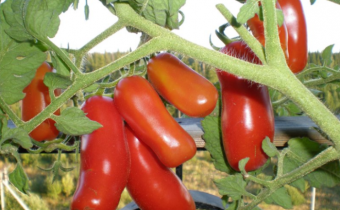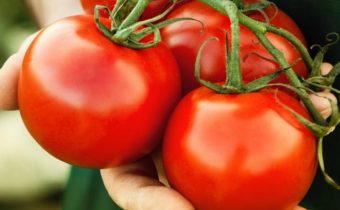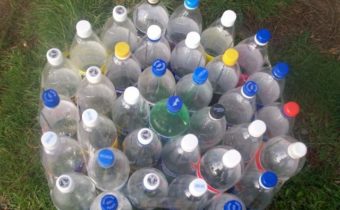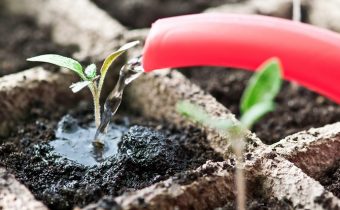About when to plant tomatoes for seedlings in Ukraine according to the lunar calendar
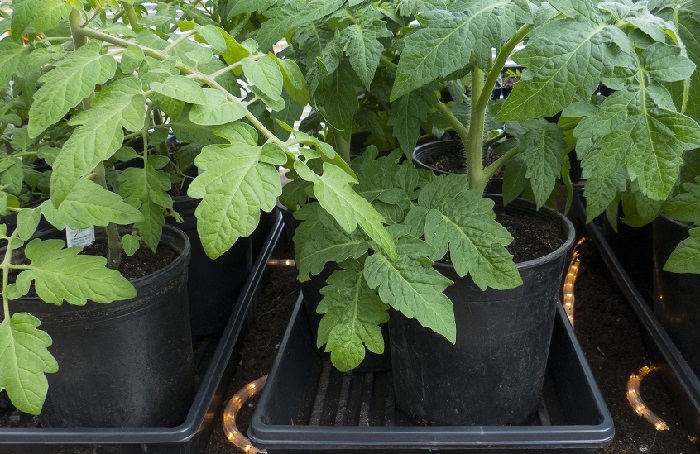
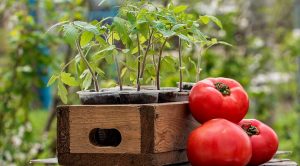 The new summer season for most gardeners begins already after the New Year, because many of them are starting to buy seeds, soil, and seedling containers, and study planting dates. The last for an experienced summer resident is an integral and very important part of the process of growing a good crop, for it is not a secret to anyone that the lunar calendar can greatly ease the work and make it possible to get a better and, most importantly, high yield. Today we will find out when to plant tomatoes for seedlings in Ukraine in 2018, and how to do it right.
The new summer season for most gardeners begins already after the New Year, because many of them are starting to buy seeds, soil, and seedling containers, and study planting dates. The last for an experienced summer resident is an integral and very important part of the process of growing a good crop, for it is not a secret to anyone that the lunar calendar can greatly ease the work and make it possible to get a better and, most importantly, high yield. Today we will find out when to plant tomatoes for seedlings in Ukraine in 2018, and how to do it right.
Climate in Ukraine - a brief description
Ukraine is a rather favorable weather country to get good yields of vegetables and berries. There is enough territory, precipitation, snow, which warms the vegetation in winter. If we talk about climate, then it is temperate, turning south into subtropical. Temperatures in the cold season are higher than in neighboring Russia, namely in its central regions. In winter, as a rule, the average temperature is kept in the range from 0 to -10 degrees, in the summer it reaches 30 or more.
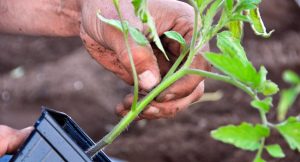 If we talk about precipitation, then they fall enough to successfully grow seedlings and crops in general. Of course, it does not rain evenly over the whole territory; a number of regions have a more arid climate. Rainfall comes from April to September regularly. The warmest regions and favorable for agriculture are the south of the country, the south-east, and the east. In general, it can be said that even novices in garden affairs can quite successfully begin to grow seedlings, and cultures subsequently, in the expanses of the country.
If we talk about precipitation, then they fall enough to successfully grow seedlings and crops in general. Of course, it does not rain evenly over the whole territory; a number of regions have a more arid climate. Rainfall comes from April to September regularly. The warmest regions and favorable for agriculture are the south of the country, the south-east, and the east. In general, it can be said that even novices in garden affairs can quite successfully begin to grow seedlings, and cultures subsequently, in the expanses of the country.
The dates of sowing tomato in seedlings in Ukraine will differ depending on the region - in the southern territories they will be 1-2 weeks earlier. Since it is a warm time here, when fragile seedlings can be transplanted outside, it comes earlier, and in spring there is a lot more sun. And the light is one of the most important conditions for growing quality, healthy seedlings. The dates of the lunar calendar, we will tell you next.
Terms and rules for growing tomato seedlings in Ukraine
So, as you could understand, knowing exactly when sowing tomatoes for seedlings in Ukraine, and not only, is very important. An experienced summer resident will not do anything until he looks into the lunar calendar, and it is different every year. Many are guided by a simple rule - those cultures that give fruit from above, you need to plant on the growing moon, those in the earth, on a decreasing one. But this is a fairly broad framework, there are more specific dates.
When to sow tomatoes in 2018:
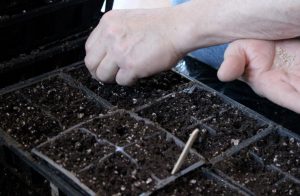
- February - 12-14, 24, 26-28;
- March 3-4, 12-15, 21-25;
- April - 8, 12, 13, 22, 26-28;
- May - 9, 15, 19, 24, 25.
As you can see, seed can be sown even in May, which is rather late. This is possible due to the fact that the cultivation of tomatoes in the open field in the southern regions in Ukraine can take a long time - the cold comes late. Varieties with a short growing season will be able to ripen and delight with vitamins without any problems. Also, the culture can successfully grow in greenhouse conditions.
The days mentioned above are considered the most favorable for sowing tomatoes, also at the same time you can safely sow cucumbers, peppers. But remember, about the full moon and the new moon, they will be in 2018 on the following days:
- February - there is no full moon in this month. New Moon - 16th;
- March is the 2nd and 31st. New Moon - 17th;
- April is the 30th. New Moon - 16th;
- May is the 29th. New Moon - the 15th.
See also: Review of the Verlioka F1 tomato hybrid:
We prepare the soil for seedlings
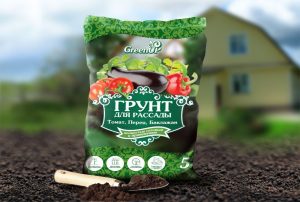 The numbers now, when sowing tomatoes for seedlings within Ukraine, you know. If you live in warmer regions, then you can plant from the second decade of February, in the rest it is better to do it closer to the second decade of March. Soil, containers and planting material itself can be bought in advance - as early as January. The main thing, pay attention to the freshness of the seeds - it is better to take those that were harvested no later than a year ago. This can significantly affect sprouts.
The numbers now, when sowing tomatoes for seedlings within Ukraine, you know. If you live in warmer regions, then you can plant from the second decade of February, in the rest it is better to do it closer to the second decade of March. Soil, containers and planting material itself can be bought in advance - as early as January. The main thing, pay attention to the freshness of the seeds - it is better to take those that were harvested no later than a year ago. This can significantly affect sprouts.
With regards to the soil, for tomatoes you can buy ready-made, universal soil mixture with a balanced composition. It is also suitable for growing peppers, cucumbers and even flowers. You can use the second option - these are peat tablets, which have now become the most popular method of planting.
Advantages of tablets:
- ease of handling;
- optimal composition;
- saving time and effort during sowing;
- the whole process is clean, when the ground often crumbles;
- pills exclude the stage of picking - one of the most trauma of dangerous moments for fragile seedlings and disliked by many summer residents.
If you prefer soil, then it will need to be prepared in advance for sowing. The fact is that often even the purchased soil is infected with parasites, and there may be diseases in it. You can use two methods for disinfection:
- About 3-5 days before sowing, pour all the soil with boiling water, you can throw manganese crystals into it. When the earth dries to a slightly wet state and the date arrives, it is sown.
- You can use another method - right in the package in which the land is sold, it is placed in a bucket with very hot water - 70-75 degrees, after which the container is covered with a lid. Such processing lasts until complete cooling - experienced gardeners say that all pathogenic flora dies.
Of course, many gardeners make their ground. It is easy, especially since all the components can be found on your site or bought in a shop for gardeners. So, you can mix in equal parts of the land from the garden with peat, here also add part of the sand for better breathability, and a glass of ash. But even this soil will need to be shed with boiling water before sowing for disinfection.
Cooking seeds
In addition to the ground one week before the planting date, you should also start preparing seeds. Most often this is done in the first week of March, in the south before. To discard empty seeds that will not germinate, you need to do the following:
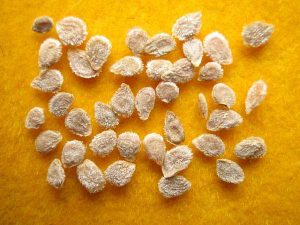
- pour cold water into a liter jar;
- put a spoonful of table salt here and mix;
- pour out the seeds and wait 15-30 minutes;
- all those seeds that are hot, remove - they are empty.
Further, it will be necessary to pickle the seed, as it may be infected with diseases.To do this, do the following, about 3 days before sowing:
- pour a glass of water;
- place some manganese crystals here to get a pink solution;
- soak the seeds for 30-60 minutes;
- rinse under running, warm water;
- dry it.
To improve the seedlings, you can warm the seeds on the battery during the day, and you can germinate them in a damp cloth, but gardeners rarely do this now, because tomatoes, therefore, sprout within a week. After all, breeders are producing more and more high-quality and good varieties so that growing tomatoes in open ground, in greenhouses in Ukraine, and not only was the simplest and most productive.
Produce sowing
So, your soil and seeds are ready, and around March 12, for most regions, sowing begins. Of course, if you have a greenhouse, then you spend the crops from the second half of February. To sow tomatoes is easy. If you use primer, the technology is as follows:
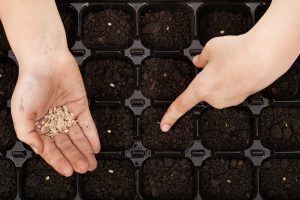
- wash containers with water and soap;
- dried soil after processing pour into it, leaving about 1 cm from the edge;
- make beards with a depth of 0.5-1 cm;
- sowing seeds 1-1.5 cm apart;
- sprinkle with a light layer of soil;
- moisten with a spray bottle, which will allow you to carefully and uniformly water crops, rather than wash them off;
- Cover everything with film and put it on a warm window-sill;
- observe the temperature of 22-25 degrees;
Shoots will appear within 7-10 days, then the film will need to be removed. Watering seedlings as needed, nutrition in the soil will be enough for them if you have a soil that was indicated above. Make sure that the seedlings have enough sun, turn it over as it grows. If you see that the saplings are being pulled out and broken, then urgently place the lighting lamps.
If you are using peat tablets:
- pour water into the tray;
- place the tablets here, hole up;
- when they become, like kegs, take them out;
- put the barrels in the tray (you can from under the semi-finished products) and place the seed inwards;
- cover with a film and put on the windowsill.
When the seedlings ascend, the film is removed, the moisture is produced with the help of water, which is poured into the tray - the barrels absorb everything. Further, when the seedlings are grown, they can be transplanted into cups with soil, which can be made of peat or cardboard. These cups you will land in the ground.
Picking
If you use tablets, then you will pass this stage. If a common container, then in the phase of 3-4 true leaves you dive saplings in separate cups. They can be plastic, cardboard, from peat. The soil is taken all the same, but, of course, fresh and decontaminated. Saplings after picking should not be put in the sun, they need to get a little stronger in the shade. Feeding is now not necessary to make.
See also: Tomatoes "Mikado": pink, black, gold, yellow and red
Fertilizers and watering seedlings
In order for your cultivation of tomatoes in the open field in Ukraine to be successful, you need to moisten seedlings and fertilize in time. In the first case, this is done as the soil dries out with warm, settled water. Feed begin to make after picks in two weeks. You can use the following scheme:
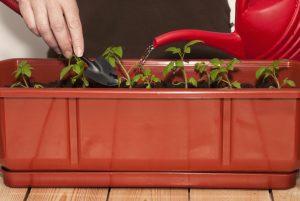
- two weeks after the picking - a spoonful of superphosphate, potassium sulphate and two spoons of Kemira are placed on a bucket of water;
- after a week, spill saplings with a slightly pinkish manganese solution;
- on the 25th day after sowing the tomatoes, you need to shed the seedlings with a solution in a bucket of water of a spoon of saltpeter;
- Once a week, you can spray the preparation for foliar feeding.
This is the main care for seedlings at home, it should also be noted about diseases of tomatoes.
Disease prevention
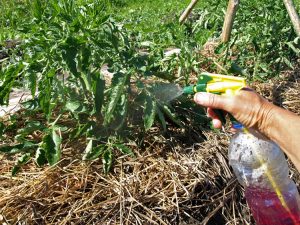 If you initially did everything as we said above, then your seedlings will be healthy. For prevention, you can spray a weak solution of manganese as the seedlings themselves, and the bushes on the beds. Watering tomatoes is necessary only as the soil dries, otherwise it will rot, parasites will appear. If the tomatoes are sick, then you can use the following tools:
If you initially did everything as we said above, then your seedlings will be healthy. For prevention, you can spray a weak solution of manganese as the seedlings themselves, and the bushes on the beds. Watering tomatoes is necessary only as the soil dries, otherwise it will rot, parasites will appear. If the tomatoes are sick, then you can use the following tools:
- from a mosaic, treatment with a solution in a liter of milk of a spoon of urea is used - once every 10 days;
- gray and root rot - "Fundazol," Barrier "," Barrier ";
- phytophthora and macroscoporosis - copper sulphate, Bordeaux mixture, Fitosporin, Trichodermin and Ordan;
- spotting - copper sulfate.
Transfer of seedlings to indoor soil
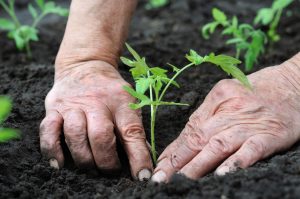 Seedlings are transferred when it has already reached 25 cm in height, has grown strong and has been pre-hardened. Any greenhouse - warm or just a cover from the film must be carefully prepared - the soil and walls are disinfected. The soil should be fertile - you can use equal parts of humus, sod land, two times less sand, and add a complex preparation here. Everything is shed for disinfection with boiling water with manganese. Wells are made at a distance of 35 cm from each other, depending on the variety. The distance between the rows of at least 50 cm. Tall varieties require support, planted them along the walls in a row.
Seedlings are transferred when it has already reached 25 cm in height, has grown strong and has been pre-hardened. Any greenhouse - warm or just a cover from the film must be carefully prepared - the soil and walls are disinfected. The soil should be fertile - you can use equal parts of humus, sod land, two times less sand, and add a complex preparation here. Everything is shed for disinfection with boiling water with manganese. Wells are made at a distance of 35 cm from each other, depending on the variety. The distance between the rows of at least 50 cm. Tall varieties require support, planted them along the walls in a row.
With regards to the timing, then in a warm greenhouse seedlings, which you sowed in February, you can transfer in early April, in the cold - in early May. The soil should be heated, and at night the temperature should not drop below 10 degrees, otherwise the tomatoes will stop growing. Care in the greenhouse and on the street is about the same - it is watering as it dries out, feeding, removing weeds, but you still need to air the greenhouses. Also remember about disease prevention.
Fertilizers can be applied as follows:
- two weeks after the transfer make nitrogen feed;
- when the flowers start to form - they spread 25 grams of azofoski and mullein per bucket of water;
- after flowering, another 2-3 additional dressings - put a spoonful of potassium sulfate and 15 grams of mullein per bucket of water or replace it with 25 grams of nitrate;
- You can use a complex mineral supplement after the first feeding with nitrogen - every 2-3 weeks.
Carrying seedlings to the street
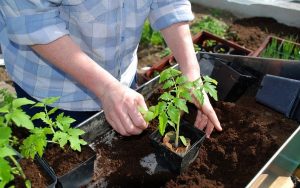 In order to transfer the seedlings to the garden, it is also necessary to pickle the soil, especially if there used to be growing potatoes and peppers, add fertilizers, and remove weeds. In the hole you can add a spoonful of superphosphate, ash, as well as part of the sand and humus. The technology is quite similar to the greenhouse, except that the dates will be much later - the 3rd decade of May and the beginning of June. The threat of frost should completely disappear, nighttime temperatures should be above 10-12 degrees, daytime temperatures should not be below 16 degrees. Rassad at this point should be about 50-55 days. It is impossible to say the exact date of transfer - all regions are different and the weather from year to year can surprise with its warmth and cold. And finally, we would like to advise you on the most productive varieties of tomatoes for open ground and greenhouses in Ukraine, which are gaining increasing popularity.
In order to transfer the seedlings to the garden, it is also necessary to pickle the soil, especially if there used to be growing potatoes and peppers, add fertilizers, and remove weeds. In the hole you can add a spoonful of superphosphate, ash, as well as part of the sand and humus. The technology is quite similar to the greenhouse, except that the dates will be much later - the 3rd decade of May and the beginning of June. The threat of frost should completely disappear, nighttime temperatures should be above 10-12 degrees, daytime temperatures should not be below 16 degrees. Rassad at this point should be about 50-55 days. It is impossible to say the exact date of transfer - all regions are different and the weather from year to year can surprise with its warmth and cold. And finally, we would like to advise you on the most productive varieties of tomatoes for open ground and greenhouses in Ukraine, which are gaining increasing popularity.
Better tomatoes for Ukraine
"Casta F1"
If you want tomatoes to be large, sweet and ripen quickly, then this variety is perfect for you.
Main advantages:
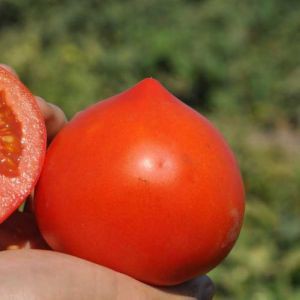
- fruit weight - 300 grams or more;
- powerful and resistant variety;
- quickly and well sets fruit;
- one hectare of planting gives more than 100 tons of tomatoes;
- growing season - 60-65 days;
- the harvest is long stored and easily transported;
- tomatoes - bright scarlet, sweet, fleshy;
- universal table appointment.
Disadvantages:
- powerful bush requires good support and a lot of space;
- sensitive to temperature extremes.
"Bagheera F1"
This is also one of the best early varieties of tomatoes for open field for Ukraine. Has an excellent reputation, and almost no “Bagira” cons.
Main advantages:
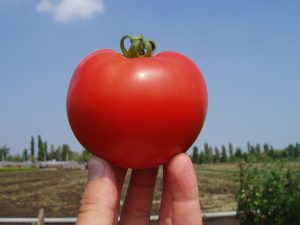
- Tomato weight - 220 grams;
- ripens early - growing season up to 65 days;
- high-yielding tomato - 100 tons per hectare;
- has high resistance to bad weather, illnesses;
- very tasty variety.
There is only one drawback - the kitchen gardens say that this tomato is better to eat fresh than to make blanks from it.
"Carbon"
If you want your fruits to be not just tasty, but also surprise the guests with their appearance, then look at this variety.
Main advantages:
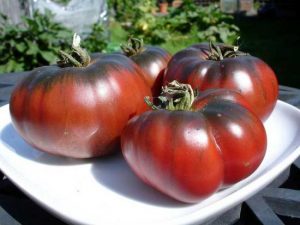
- unusual color - dark red, sometimes black;
- tall and powerful bush - up to 1.8 meters;
- disease resistant;
- grown on the street and in greenhouses, but prefers the latter;
- large-fruited variety - more than 300 grams;
- very tasty tomatoes.
Disadvantages:
- demanding of heat;
- uneven surface;
- requires support and a place for growing;
- fruits ripen for a long time.
See also: Tomato "Black Cluster F1" - is it necessary in the garden?
Rufus F1
This tomato has no flaws, so let's find out more of its merits.
Main advantages:
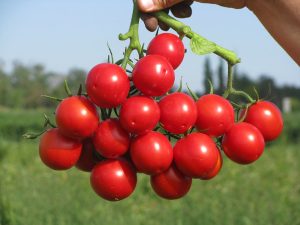
- high yield - more than 100 tons per hectare;
- not sick and not afraid of parasites;
- early ripe, not afraid of weather adversity;
- fruit weight - 60 grams, more than 100 tomatoes can be collected from one bush;
- ideal for whole-fruit canning;
- high fruit set
"Liana"
One of the most popular varieties that are grown on the territory of Ukraine and Russia. It has a fairly compact bush and is suitable for small areas and small greenhouses.
Main advantages:
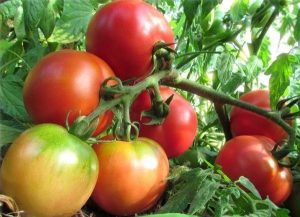
- low bushes - up to 50 cm;
- ripens early;
- fruits do not crack, tasty and long lie;
- has a universal table purpose;
- not afraid of changes in temperature;
- fruit weight - up to 100 grams, which is convenient for whole fruit preservation.
Disadvantages:
- does not have absolute resistance to diseases;
- pests can annoy.
These tomatoes you can safely choose for your plot. Proper farming will help you get excellent yields of quality tomatoes.
Observing the recommendations of the lunar calendar and carefully caring for plantings, you get your vitamin tomatoes, which will be stored for a long time and please in the winter twists.
Video recommendations on when to plant tomatoes for seedlings


